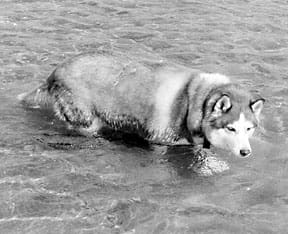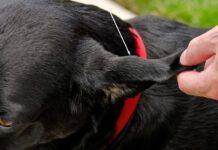Tova was raised just like a little princess. A copper and cream colored Siberian Husky, she belonged to a very old man who spoiled and overfed her with any kind of food that seemed to make her happy: Spam, canned people food and canned dog food, Burger King and McDonald’s hamburgers, etc. Her owner had a part-time job picking up and delivering blood samples, and he brought Tova with him on his driving route, where she enjoyed getting cookie treats from her many admirers along the old man’s route. But beyond walking to and from the car at each stop, Tova and her owner got very little exercise. By the time she was seven years old, she weighed 83 pounds – at least 20 pounds more than she should have.
At that point, her story took a sad turn. Her owner died, and while the old man’s relatives tried to figure out what to do with Tova, they left her in his garage. He had left instructions with his family for Tova to be euthanized when he died, but they could not find it in their hearts to put her down. However, no one in the family wanted her, either. Poor Tova spent at least six weeks in the garage, mourning, and waiting for her next ride in the car.
A friend of a friend

Fortunately, someone heard about Tova’s plight from a friend. Paula J. Sperry, a chiropractor from Eastham, Massachusetts, had recently lost a beloved dog to old age, and was looking for another dog. She called the old man’s relatives and asked permission to come and see Tova; when she met the husky dog, she immediately fell in love with Tova’s sweet personality.
Confused and upset, however, the man’s relatives could not bring themselves to turn Tova over to any individual. They told Sperry they weren’t going to give the dog to anyone.
Sperry just couldn’t get Tova out of her mind, however, and called the family later to ask about the dog again. That’s when she discovered that the family had brought Tova to an animal shelter! If she wanted the dog, Sperry was told, she would have to “go through the proper channels.”
It’s a good thing that Tova had met Sperry prior to arriving at the animal shelter; she didn’t appear all that attractive to potential adopters. She was way overweight, and appeared to have numerous health and behavior problems. She was stiff, dirty, and had skin problems. She lay down most of the time, completely lethargic and depressed, almost unable to lift her head. When she did walk, her head stayed down and she could not move her tail. She was prone to bouts of colitis, with small amounts of blood and mucous in her stool. Furthermore, she was urinary incontinent, leaving puddles of urine wherever she lay down.
But Sperry knew that Tova hadn’t always been like that; she felt the dog’s condition was understandable considering the recent sad events in her life. She didn’t know whether or not Tova could be restored to her past happiness, but she wanted to try. She filled out the adoption papers and put Tova in her car to take her home.
Inauspicious beginning
That car ride didn’t seem like an auspicious start to their relationship. Sperry drove along with Tova woo-wooing the whole way, distant and sad. Sperry imagined the dog was mourning the old man, and she herself was still mourning the loss of her old dog; they cried together the whole way to Sperry’s home.
Sperry took Tova to a veterinarian right away, seeking help for her many symptoms. The fat Husky was exhibiting a “laundry list” of problems, but the veterinarian felt only one was medically treatable: the urinary incontinence. That could be cleared up with a prescription for diethylstilbestrol (DES), the veterinarian said.
But Sperry was reluctant to use such a controversial drug as the first line of attack. DES was used in humans from 1940 to 1971 as a treatment to prevent spontaneous abortion; later, it was discovered the drug caused a multitude of health problems in the women who used it, and even more in the sons and daughters of these women. While DES is used successfully today in other applications and much lower dosages, Sperry felt there were better alternatives to explore first.
Alternative tack
Following the veterinary examination, Sperry felt it was time to put her medical training into practice.
As a chiropractor, Sperry has successfully treated a number of human patients for the same symptoms that Tova was suffering. She also had worked with veterinarians to expand her knowledge of animal anatomy, and, with the veterinarians’ approbation, had used chiropractic adjustments on a number of animals with great results.
There were a number of things about Tova that led her to think that the dog would be a very good candidate for the therapy. Sperry asked Tova’s veterinarian about the location of the nerve supply that controls the bladder and associated muscles in the canine spine. To her credit, the veterinarian found the question interesting and she researched the information for Sperry.
Back at home, Sperry examined and palpated Tova’s spine. She looked for places where the spinal joints failed to move freely, and where the muscles or skin twitched or jumped in response to her probing. Armed with this information, and with the information from her veterinarian, she made several adjustments to Tova’s spine.
No change in Tova’s condition was immediately discernible, a fact that didn’t worry Sperry. “Chiropractic might work right away, or it might take weeks and dozens of adjustments to work,” she says. “Like all natural healing methods – massage, acupuncture, herbs – chiropractic is not a magic bullet. You have to give it time.”
A couple of days later, Sperry gave Tova another adjustment. This time, Tova went several days without losing urine, and Sperry knew she on the right track. She made a final adjustment to Tova’s lower back area, which completely resolved the problem. Six years later, Tova still has total control of her urinary system.
Given the total success of the first round of chiropractic on her dog, Sperry decided to try making an adjustment to another problem area she had identified in Tova’s spine. When Sperry palpated Tova’s lower neck, she found arthritic nodules in the vertebrae in that area. She speculated that this condition, as well as Tova’s habitual and unusual posture – head held low and an unmoving tail – would benefit from adjustments of those spinal vertebrae.
After carefully making an adjustment to Tova’s neck, Sperry noticed almost immediate improvement in Tova’s mood, posture, and especially her movement. “It took about a day. The morning after the adjustment, Tova had her head up, and she started wagging her tail, and her personality changed; she just improved so much.” It could be, Sperry theorizes, that the miserable dog had suffered chronic pain from a misaligned spine for so long that she had become emotionally “shut down” and stoic. “I think she had probably been in fairly serious pain,” says Sperry. The change in her was huge.”
Over the next weeks, Sperry made more adjustments to her dog’s back and neck. The therapy produced drastic positive results. Soon Tova was able to wag her whole body!
Other support
Sperry knew from her human patients that chiropractic, like all systems of therapy, works best in conjunction with a complete health-improving plan. She weaned Tova from her high fat, low quality diet, and put her on a rotation diet, introducing different foods for fairly long periods of time. She monitored Tova’s reactions to each food, noting those foods that seemed to trigger mild allergic reactions. Tova responded to lamb, pork, and corn with itchy skin and colitis, but did well on chicken, salmon, and beef. On these foods, she grew a healthier coat and displayed no bowel problems.
Sperry feeds Tova a high-quality dog food, Abady Dog Food, mixed with human food and nutritional supplements. Tova receives one “Okra Pepsin” capsule (made by Standard Process ) per day, which Sperry credits with keeping Tova’s digestive system on track. She also eats one-half to one egg yolks each day, which seems to help her coat. She also gets a teaspoon or so of Ester C (powdered vitamin C supplement, intended for healthy bones and gums), and two to three droppers of Coyote Springs’ “Tasha’s Herbs for Dogs, Skin and Hair Formula.” When her psoriasis flares up, Sperry gives her 500 milligrams of goldenseal powder daily until the condition resolves.
Sperry also started Tova on a regimen of gentle daily exercise, starting slowly and working up to a regular daily walk. Slowly, her weight decreased and her energy level and stamina rose.
Wearing a collar seems to exacerbate Tova’s spinal problems, so when it is necessary for her to be on a leash, Sperry usually uses a harness.
Today, Tova is 13 years old, and, according to Sperry, when people guess her age, they estimate her to be eight or nine years old. She weighs a healthy and fit 58 pounds, and though she still requires occasional spinal adjustments to maintain flexibility, she is mobile and active. “I’m so glad to have her in my life; she’s just a joy,” says Sperry; if Tova could talk, she’d probably say the same for her human companion.
-By Lyn Richards





